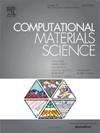Electronic properties of two-dimensional nanocarbons formed by truxene-like building blocks
IF 3.1
3区 材料科学
Q2 MATERIALS SCIENCE, MULTIDISCIPLINARY
引用次数: 0
Abstract
Nanocarbons obtained from well-known molecular precursors can provide nanostructures with a diversity of electronic behaviors. In addition to an array of theoretical results, experimental studies have motivated developments in the field with the growth of quantum dots with nontrivial configurations of nonhexagonal rings. For example, a truxene (Trx) molecular unit can display either a -carbon-containing configuration or a full- variation. The case has a large gap between its frontier states, unlike the counterpart, which has unpaired electrons. Here, we use computational simulations to propose a set of Trx-based 2D nanocarbons with electronic properties dictated by the anchoring points of the block-to-block connections. The interplay between Trx’s molecular levels and details of the 2D lattices results in systems ranging from metals to wide-gap semiconductors. This versatility is rationalized in terms of bonds formed through unpaired electrons from sequential Trxs, as verified with the aid of a graph-theoretical analysis.

求助全文
约1分钟内获得全文
求助全文
来源期刊

Computational Materials Science
工程技术-材料科学:综合
CiteScore
6.50
自引率
6.10%
发文量
665
审稿时长
26 days
期刊介绍:
The goal of Computational Materials Science is to report on results that provide new or unique insights into, or significantly expand our understanding of, the properties of materials or phenomena associated with their design, synthesis, processing, characterization, and utilization. To be relevant to the journal, the results should be applied or applicable to specific material systems that are discussed within the submission.
 求助内容:
求助内容: 应助结果提醒方式:
应助结果提醒方式:


